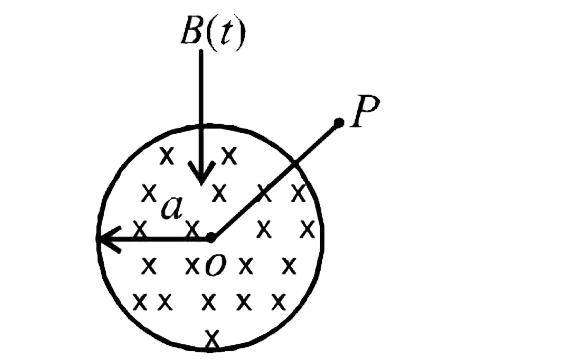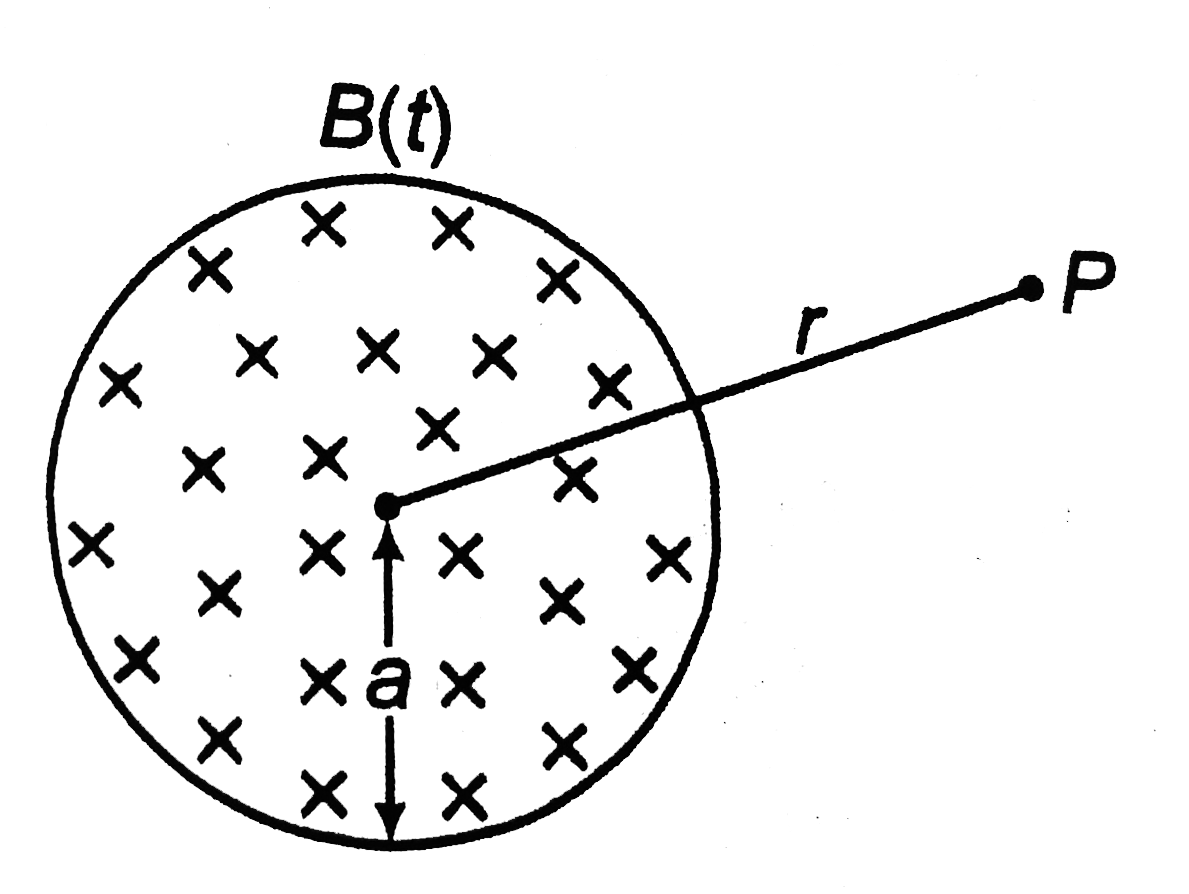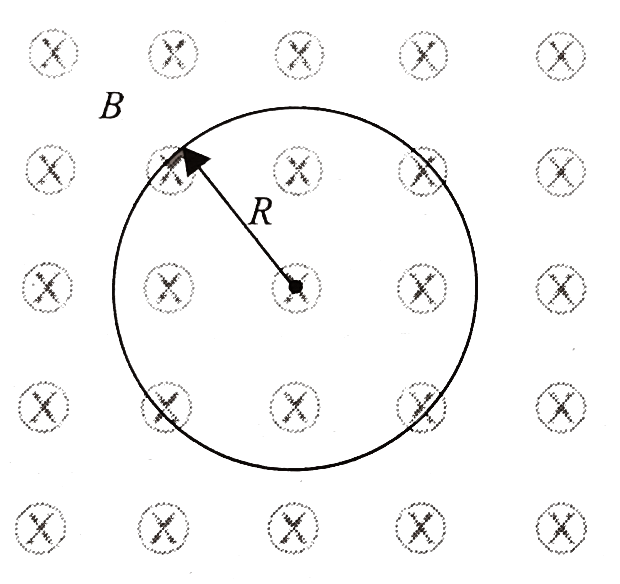A uniform magnetic field exists in a circular region of radius R centred at O. The field is perpendicular to the plane of paper and is strength varies with time as . Find the induced electric field at a distance r from the centre for (i), (ii) . Also, plot a graph between and r for both the cases.
To solve the problem, we need to find the induced electric field at a distance r from the center O of a circular region where a magnetic field B is varying with time as B=B0t. We will analyze two cases: (i) when r<R and (ii) when r>R.
1. Identify the Magnetic Flux:
The magnetic flux ΦB through a circular area of radius r is given by:
ΦB=B⋅A=B0t⋅πr2
2. Calculate the Rate of Change of Magnetic Flux:
We need to find the rate of change of magnetic flux with respect to time:
dΦBdt=ddt(B0t⋅πr2)=B0πr2
3. Use Faraday's Law of Induction:
Faraday's law states that the induced electromotive force (EMF) E is equal to the negative rate of change of magnetic flux:
E=−dΦBdt=−B0πr2
4. Relate EMF to Induced Electric Field:
The induced EMF can also be expressed in terms of the electric field E around the circumference of the circle of radius r:
E=E⋅(2πr)
5. Set the Two Expressions for EMF Equal:
Equating the two expressions for EMF:
E⋅(2πr)=B0πr2
6. Solve for the Induced Electric Field E:
E=B0r2
Case (ii): r>R
1. Identify the Magnetic Flux:
In this case, the magnetic field only exists in the circular region of radius R. Thus, the magnetic flux through a circle of radius r (where r>R) is:
ΦB=B⋅A=B0t⋅πR2
2. Calculate the Rate of Change of Magnetic Flux:
dΦBdt=ddt(B0t⋅πR2)=B0πR2
3. Use Faraday's Law of Induction:
E=−dΦBdt=−B0πR2
4. Relate EMF to Induced Electric Field:
Again, using the relationship with the electric field:
E=E⋅(2πr)
5. Set the Two Expressions for EMF Equal:
E⋅(2πr)=B0πR2
6. Solve for the Induced Electric Field E:
E=B0R22r
Summary of Results:
- For r<R:
E=B0r2
- For r>R:
E=B0R22r
Graph of |E| vs r:
- For r<R, E increases linearly with r.
- For r>R, E decreases inversely with r.
The magnetic flux ΦB through a circular area of radius r is given by:
ΦB=B⋅A=B0t⋅πr2
We need to find the rate of change of magnetic flux with respect to time:
dΦBdt=ddt(B0t⋅πr2)=B0πr2
Faraday's law states that the induced electromotive force (EMF) E is equal to the negative rate of change of magnetic flux:
E=−dΦBdt=−B0πr2
The induced EMF can also be expressed in terms of the electric field E around the circumference of the circle of radius r:
E=E⋅(2πr)
Equating the two expressions for EMF:
E⋅(2πr)=B0πr2
E=B0r2
In this case, the magnetic field only exists in the circular region of radius R. Thus, the magnetic flux through a circle of radius r (where r>R) is:
ΦB=B⋅A=B0t⋅πR2
dΦBdt=ddt(B0t⋅πR2)=B0πR2
E=−dΦBdt=−B0πR2
Again, using the relationship with the electric field:
E=E⋅(2πr)
E⋅(2πr)=B0πR2
E=B0R22r
- For r<R:
E=B0r2
- For r>R:
E=B0R22r
- For r<R, E increases linearly with r.
- For r>R, E decreases inversely with r.
Topper's Solved these Questions
- ELECTROMAGNETIC INDUCTIONBOOK - DC PANDEY ENGLISHCHAPTER - ELECTROMAGNETIC INDUCTIONEXERCISE - Check point
60 Videos
- ELECTROMAGNETIC INDUCTIONBOOK - DC PANDEY ENGLISHCHAPTER - ELECTROMAGNETIC INDUCTIONEXERCISE - Taking it together
119 Videos
- ELECTROMAGNETIC INDUCTIONBOOK - DC PANDEY ENGLISHCHAPTER - ELECTROMAGNETIC INDUCTIONEXERCISE - Level 2 Subjective
20 Videos
- CURRENT ELECTRICITYBOOK - DC PANDEY ENGLISHCHAPTER - CURRENT ELECTRICITYEXERCISE - Medical entrances gallery
97 Videos
- ELECTROMAGNETIC WAVESBOOK - DC PANDEY ENGLISHCHAPTER - ELECTROMAGNETIC WAVESEXERCISE - Sec C
22 Videos
Similar Questions
A uniform but time-varying magnetic field B(t) exists in a circular region of radius a and is directed into the plane of the paper, as shown. The magnitude of the induced electric field at point P at a distance r from the centre of the circular region

View SolutionA uniform but time varying magnetic field B(t) exist in a circular region of radius a and is directed into the plane of the paper as shown. The magnitude of the induced electric field at point P at a distance r form the centre of the circular region.

View Solution
Knowledge Check
There is a solid sphere of radius R having uniformly distributed charge throughout it. What is the relation between electric field E and distance r from the centre (r is less than R) ?
AE∝r−2BE∝r−1CE∝rDE∝r2
Figure shows a circular region of radius R in which uniform magnetic field B exists. The magnetic field is increasing at a rate dBdt. The induced electric field at a distance r from the centre for r<R is

View SolutionA time varying uniform magnetic field passes through a circular region of radius R. The magnetic field is directed outwards and it is a function of radial distance 'r' and time 't' according to relation B-B_(0)rt. The induced electric field strength at a radial distance R/2 from the centre will be.
View SolutionIf the potential at the centre of a uniformly charged hollow sphere of radius R is V, then electric field at a distance r from the centre of sphere will be (r>R).

View SolutionA conducting loop of radius R is present in a uniform magnetic field B perpendicular to the plane of the ring. If radius R varies as a function of time t, as R=R0+t. The emf induced in the loop is

View SolutionThe field due to a magnet at a distance R~ from the centre of the magnet is proportional
View SolutionThe flux of electric field through the circular region of radius r as shown in the figure is
_PHY_E05_291_Q01.png)
View SolutionA circular coil of radius R carries an electric current. The magnetic field due to the coil at a point on the axis of the coil located at a distance r from the centre of the coil, such that r>>R, varies as
View Solution
